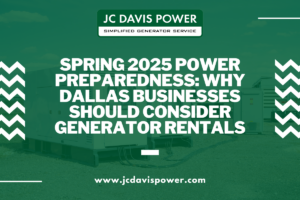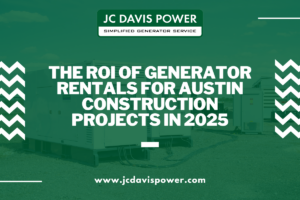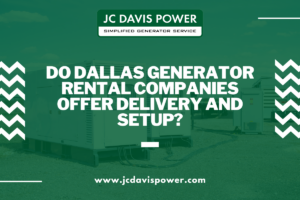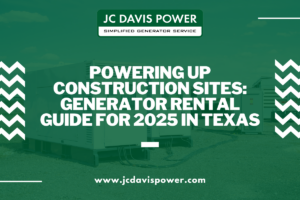Key Takeaways
- Texas businesses face unique power risks due to the isolated ERCOT grid system
- Power outages cost Texas businesses an average of $1,000 per hour for small businesses and up to $8,000 per hour for mid-sized companies
- Proper generator sizing is critical – businesses should calculate essential power loads before selecting a solution
- Backup power systems require regular testing and maintenance to ensure reliability
- Having an emergency power plan can be the difference between quick recovery and permanent closure
- Generator rental options provide flexibility for seasonal threats without major capital investment
The Texas Power Challenge: Why Your Business Needs Backup Power
Texas weather doesn’t play by the rules. From freezing winter storms to powerful hurricanes and scorching summer heat waves, Texas businesses face weather challenges that can knock out power when you least expect it.
For Texas business owners, power outages mean more than just sitting in the dark. They mean lost sales, spoiled inventory, damaged equipment, and unhappy customers. What makes the situation in Texas different from other states? One big reason: Texas has its own power grid.
Unlike most states that connect to larger national grids, Texas stands alone with its independent system called ERCOT (Electric Reliability Council of Texas). This independence means when things go wrong, Texas can’t easily borrow power from neighboring states. The result? Texas businesses need to be extra prepared with their own backup power plans.
In this guide, we’ll walk through everything Texas business owners need to know about backup power: how to figure out what you need, what options work best for different businesses, how to create a solid emergency plan, and smart ways to protect your business without breaking the bank.
Understanding Why the Texas Power Grid Is Different
The Stand-Alone ERCOT System
The Texas power grid operates differently from the rest of the country. While most states connect to either the Eastern or Western Interconnection grids, about 90% of Texas runs on its own isolated system called ERCOT. This independence started decades ago when Texas power companies wanted to avoid federal regulations.
This independence has benefits, like potentially lower energy costs. But it comes with a big downside: when major problems hit, Texas can’t easily pull electricity from other states. During extreme weather, this isolation can turn small problems into major crises.
When the Lights Went Out: Recent Texas Power Failures
The February 2021 winter storm showed just how vulnerable the Texas energy grid reliability can be. When temperatures dropped to record lows, the system couldn’t keep up with demand. The result? More than 4.5 million Texas homes and businesses lost power, some for several days.
For businesses, the costs were enormous. According to data from the Federal Reserve Bank of Dallas, the storm caused an estimated $80-$130 billion in economic damage across the state. Small businesses suffered the most, with many facing:
- Lost inventory and products
- Damage to equipment from power surges when electricity returned
- Lost business during critical operating days
- Water damage from frozen and burst pipes
- Staff unable to work, resulting in lost productivity
People Also Ask: How much does a power outage cost a business?
The average small business loses approximately $1,000 per hour during a power outage, while medium-sized businesses can lose $8,000 per hour or more. For larger operations like data centers, costs can reach $9,000 per minute.
Seasonal Threats to Texas Power
Texas faces year-round threats to power stability:
Winter Storms: Though less frequent, these cause the most widespread outages when they do hit. The combination of high heating demand and equipment freezing can knock out generation facilities.
Hurricane Season: Running from June through November, hurricanes and tropical storms threaten coastal businesses with both wind damage and flooding that affects power infrastructure.
Summer Heat: Texas summers push the grid to its limits. When temperatures soar above 100°F, air conditioning use spikes, creating peak demand management challenges that can lead to rolling blackouts.
How Vulnerable Is Your Business to Power Outages?
Critical Operations Assessment: What Systems Need Power?
The first step in preparing for power outages is understanding what parts of your business absolutely need electricity. Different businesses have different critical systems:
- Retail: Point-of-sale systems, refrigeration, security systems
- Restaurants: Refrigeration, cooking equipment, ventilation
- Healthcare: Medical devices, patient records, climate control
- Manufacturing: Production equipment, safety systems, inventory management
- Office-based businesses: Servers, computers, communication systems
Take time to list every system that depends on electricity. Then rank them by how essential they are to your operation. This creates your business continuity planning foundation.
For each system, calculate how long you can afford to be without power before facing serious consequences. Some operations might need immediate backup power, while others could wait hours or even days.
Calculating Your Power Requirements
Once you know which systems need power, you need to figure out how much power they require. This determines what size backup system you’ll need.
To calculate your power needs:
- List all essential equipment that needs backup power
- Find the starting (surge) wattage and running wattage for each item
- Add the total running watts for continuous operation
- Make sure your generator can handle the highest startup surge
Here’s a simple example for a small retail shop:
| Equipment | Running Watts | Starting Watts |
|---|---|---|
| Cash register/POS | 300 | 300 |
| Security system | 500 | 500 |
| Refrigerator | 700 | 2,100 |
| Lighting (6 LED fixtures) | 300 | 300 |
| WiFi router | 10 | 10 |
| TOTAL | 1,810 | 2,100 |
This business would need at least a 2,500-watt generator to handle the startup surge from the refrigerator. For kW generator sizing, remember that 1,000 watts equals 1 kilowatt (kW).
People Also Ask: What size generator does my business need?
For most small businesses, generators ranging from 5-50 kW are sufficient. Medium-sized operations typically require 50-150 kW, while large facilities may need 150+ kW systems. Always have a professional perform a detailed load analysis to determine the exact size needed for your specific operation.
Industry Requirements and Insurance Considerations
Certain industries face strict requirements for backup power:
- Healthcare facilities must maintain power for critical care equipment
- Restaurants must keep refrigeration running to prevent food spoilage
- Data centers require uninterrupted power to maintain uptime guarantees
Your insurance policy might also have requirements about business continuity planning. Some insurers offer lower premiums for businesses with proper backup power systems. Check your policy to see if having emergency power could save you money on insurance.
Backup Power Solutions for Every Business Size
Generator Types: Finding Your Best Fit
Businesses have several options when it comes to emergency generators:
Permanent Standby Generators
- Automatically turn on when power fails
- Run on natural gas, diesel, or propane
- Require professional installation
- Best for: Businesses that need immediate, hassle-free power recovery
Portable Generators
- Lower initial cost
- Can be moved where needed
- Typically run on gasoline or propane
- Require manual startup and connection
- Best for: Smaller businesses with basic power needs or limited budgets
Inverter Generators
- Provide cleaner power for sensitive electronics
- Generally quieter operation
- More fuel-efficient
- Best for: Businesses with computers, servers, or precision equipment
Rent vs. Buy: Making the Smart Financial Choice
Not every business needs to purchase a generator. For many Texas businesses, commercial generator rental makes more economic sense.
Rental Advantages:
- No large upfront investment
- Maintenance handled by the rental company
- Can scale up or down based on seasonal needs
- No storage concerns during off-seasons
Purchase Advantages:
- Lower long-term cost if used frequently
- Immediate availability during widespread outages
- Potential tax benefits as a capital investment
- Customized to your specific requirements
For businesses in areas with frequent outages, purchasing often makes sense. For others who mainly need coverage during storm seasons, rental might be the smarter option.
People Also Ask: How much does it cost to rent a commercial generator in Texas?
Commercial generator rental costs in Texas typically range from $125-$500 per day for smaller units (20-50 kW), $500-$1,200 per day for medium-sized generators (50-150 kW), and $1,200-$3,000+ per day for larger units (150+ kW). Many companies offer weekly or monthly rates that provide significant discounts for longer rentals.
Beyond Generators: Additional Power Protection
Generators aren’t the only way to maintain power during outages. Consider these supplementary options:
Uninterruptible Power Supply (UPS)
- Battery systems that provide instant power when electricity fails
- Perfect for keeping computers and sensitive equipment running
- Typically provide 5-30 minutes of power—enough to save data and shut down properly
- Can be used with generators to provide continuous power during generator startup
Battery Backup Systems
- Longer-lasting than UPS systems
- Can power essential systems for hours
- Quiet and emission-free operation
- Particularly useful for smaller loads like computers, phones, and essential lighting
Solar + Storage
- Combines solar panels with battery storage
- Provides power even when the grid is down
- Reduces energy costs year-round
- Tax incentives available for installation
Creating Your Power Outage Response Plan
Building a Business Continuity Strategy
Having equipment is only half the solution. You also need a clear plan for what happens when the power goes out. Your business continuity planning should include:
- Clear decision triggers: At what point do you activate your backup power?
- Step-by-step procedures: Who does what when power fails?
- Equipment operation instructions: Make sure multiple staff members know how to start and operate backup systems
- Safety protocols: Proper ventilation for generators, fire safety, etc.
- Conservation strategies: How to extend fuel or battery life by powering only the most critical systems
Every employee should understand their role during a power outage. Create simple, clear instruction sheets and post them where they can be found easily, even in the dark.
Keeping Communication Lines Open
When power fails, communication often fails with it. Plan for how you’ll stay connected:
- Keep charged cell phones and backup battery packs ready
- Consider satellite phones for critical communications during major disasters
- Establish a phone tree or text message system to reach all employees
- Prepare templates for customer communications about closure or limited service
- Have battery-powered or hand-crank radios for emergency information
People Also Ask: How do you prepare a business for a power outage in Texas?
- Create an emergency contact list with employee phone numbers, utility contacts, and service providers
- Install surge protectors on all sensitive equipment
- Establish backup data procedures and regular cloud backups
- Stock emergency supplies: flashlights, batteries, first-aid kits
- Train employees on manual overrides for electronic systems (like security doors)
- Develop and practice an evacuation plan if the building becomes unsafe
- Prepare customer communication templates for different outage situations
Testing Makes Perfect: Maintenance and Practice
A backup power system that doesn’t work when needed is worse than having no system at all—it creates a false sense of security. Regular testing and maintenance are essential:
- Run generators under load monthly
- Check fuel quality and replace old fuel
- Inspect batteries and connections quarterly
- Conduct full power outage drills twice yearly
- Keep detailed maintenance logs
For rental equipment, confirm the generator maintenance schedule with your provider. Ask about their testing procedures and what guarantees they offer regarding equipment reliability.
Installing Your Emergency Power System
Location and Safety Considerations
Proper installation of backup power systems requires careful planning:
Generator Placement:
- At least 5 feet from buildings and away from windows and doors
- On level ground, protected from flooding
- With adequate ventilation to prevent carbon monoxide buildup
- Accessible for maintenance and refueling
- Compliant with local noise ordinances
Permit Requirements:
Most Texas municipalities require permits for permanent generator installations. These typically cover:
- Electrical connections
- Fuel line installation (for natural gas or propane)
- Concrete pad requirements
- Noise restrictions
- Distance from property lines
Working with a licensed installer ensures your system meets all local codes and safety requirements.
Critical Components for Reliable Backup Power
A complete emergency power system includes more than just the generator itself:
Automatic Transfer Switch
The automatic transfer switch is the brain of your backup power system. This device:
- Detects when utility power fails
- Automatically signals the generator to start
- Switches your electrical load to the generator once it’s running
- Transfers back to utility power when it’s restored
- Protects against back-feeding electricity into the grid
Fuel Storage and Supply
Different fuel types have different storage requirements:
- Diesel: Typically stored in a base tank under the generator or a separate tank
- Natural gas: Connected to existing gas lines, no storage needed
- Propane: Requires a separate tank with proper safety clearances
For extended outages, having a reliable fuel supplier is crucial. Establish relationships with multiple suppliers before storm season begins.
Finding the Right Power Solution Partner
The right partner makes all the difference when setting up emergency power. When evaluating providers for power restoration services Texas, look for:
- Texas-specific experience with local weather challenges
- 24/7 emergency response capabilities
- Proper licensing and insurance
- Regular maintenance plans
- Clear, detailed contracts with no hidden fees
- References from similar businesses
Ask potential providers these questions:
- What is your average response time during widespread outages?
- Do you prioritize certain customers during major events?
- What guarantees do you offer regarding equipment performance?
- What training do you provide for our staff?
The Financial Side of Backup Power
Understanding the True Cost of Power Outages
The most compelling reason to invest in backup power is understanding what outages really cost your business:
Direct Costs:
- Lost sales during downtime
- Inventory loss (especially for perishable goods)
- Equipment damage from power surges
- Product quality issues during partial power
Indirect Costs:
- Customer loyalty and reputation damage
- Employee productivity loss
- Recovery expenses (overtime, rush shipping, etc.)
- Market share loss to competitors who stayed open
For most businesses, a single day-long outage costs far more than the annual investment in backup power solutions.
Funding Your Backup Power Solution
Several options exist to make emergency power systems more affordable:
Rental and Lease Options:
- Generator rental during peak storm seasons
- Equipment leasing for a fixed monthly cost
- Rent-to-own programs that build equity
Financing Programs:
- Equipment-specific loans with the generator as collateral
- Small Business Administration (SBA) disaster preparedness loans
- Business lines of credit for emergency equipment
Tax Advantages:
- Section 179 deductions for equipment purchases
- Depreciation benefits for capital investments
- Potential qualification for resilience or energy efficiency incentives
Beyond Emergencies: Additional Value from Backup Power
Backup power systems can provide value even when the grid is running normally:
Peak Shaving:
Running generators during times of highest electricity rates can reduce utility bills
Demand Response Programs:
Some utilities pay businesses to reduce grid load during peak times by switching to generator power
Power Quality Improvement:
Generator systems with power conditioning can protect sensitive equipment from everyday voltage fluctuations
Staying Ready: Ongoing System Management
Maintenance Essentials for Reliable Performance
Regular maintenance is crucial for ensuring your backup power system works when needed:
Monthly Tasks:
- Test-run the generator under load
- Check oil and coolant levels
- Inspect batteries and connections
- Verify fuel quality and quantity
Annual Professional Maintenance:
- Oil and filter changes
- Fuel system cleaning
- Cooling system service
- Electrical system inspection
- Load bank testing
Modern Monitoring Technology
Today’s backup power systems can include sophisticated monitoring features:
Remote Monitoring Systems:
- Alert you to problems via text or email
- Provide real-time status updates
- Track fuel levels and runtime
- Schedule automatic testing
Automated Testing:
- Conducts regular self-tests without human intervention
- Documents results for compliance and maintenance records
- Alerts you only when issues are detected
These technologies provide peace of mind and reduce the need for manual checks, especially for businesses with multiple locations.
Staff Training for Power Emergencies
Even the best equipment requires trained people to use it effectively:
- Train multiple employees on generator startup procedures
- Create simple, visual guides for emergency power operations
- Conduct regular drills so procedures become second nature
- Cross-train staff so absences don’t create vulnerabilities
Review and update your training after each actual outage to incorporate lessons learned.
Taking Action: Your Emergency Power Checklist
Preparing for power outages doesn’t have to be overwhelming. Follow these steps to get started:
- List your critical power needs and calculate your requirements
- Evaluate your options: permanent installation, portable generator, or rental arrangements
- Create a written emergency power plan with clear staff responsibilities
- Establish relationships with reliable equipment providers before storm season
- Set up a regular testing and maintenance schedule
- Train multiple staff members on all emergency procedures
- Review and update your plan annually
Remember that the time to prepare is before storm warnings appear on the forecast. Once severe weather threatens, equipment and service providers quickly become overbooked.
Conclusion: Power Through Any Storm
Texas businesses face unique challenges when it comes to power reliability. The independent nature of the Texas grid means businesses need to take extra precautions to ensure continuity during outages.
By understanding your power needs, selecting the right backup solutions, and creating a comprehensive response plan, you can position your business to weather any storm. The investment in emergency power isn’t just about preventing losses—it’s about gaining a competitive advantage by remaining operational when others cannot.
Don’t wait until the next major storm is on the horizon. Contact JC Davis Power today or visit our Texas services page to discuss your business’s emergency power needs. Our team of experts will help you develop a customized solution that keeps your business running no matter what weather comes your way.
Your business has worked too hard to let a power outage shut you down. Take control of your power future today. “





